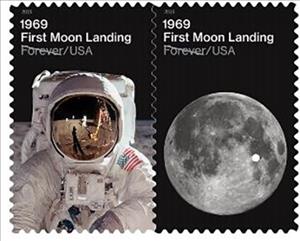Se-tenant: 50th Anniversary of Moon Landing (United States of America 2019)
50th Anniversary of Moon Landing (United States of America 2019)
19 July (United States of America ) within release 50th Anniversary of Moon Landing (2019) goes into circulation Se-tenant 50th Anniversary of Moon Landing face value 2*FOREVER No Face Value
| Se-tenant 50th Anniversary of Moon Landing in catalogues | |
|---|---|
| Michel: | Mi: US 5636-5637 |
| Stamp Number: | Sn: US 5399-5400 |
Se-tenant is horizontal format.
Printed in panes containing 12 horizontal se-tenant pairs. Face value US$0.55 per stamp on day of issueAlso in the issue 50th Anniversary of Moon Landing (2019):
- Stamp - Moon face value FOREVER;
- Stamp - Buzz Aldrin poses on the Moon face value FOREVER;
- Se-tenant - 50th Anniversary of Moon Landing face value 2*FOREVER;
Se-tenant 50th Anniversary of Moon Landing it reflects the thematic directions:
An anniversary is the date on which an event took place or an institution was founded in a previous year, and may also refer to the commemoration or celebration of that event. For example, the first event is the initial occurrence or, if planned, the inaugural of the event. One year later would be the first anniversary of that event. The word was first used for Catholic feasts to commemorate saints. Most countries celebrate national anniversaries, typically called national days. These could be the date of independence of the nation or the adoption of a new constitution or form of government. The important dates in a sitting monarch's reign may also be commemorated, an event often referred to as a "Jubilee".
An astronaut (from the Ancient Greek ἄστρον (astron), meaning 'star', and ναύτης (nautes), meaning 'sailor') is a person trained, equipped, and deployed by a human spaceflight program to serve as a commander or crew member aboard a spacecraft. Although generally reserved for professional space travelers, the term is sometimes applied to anyone who travels into space, including scientists, politicians, journalists, and tourists
The Moon is Earth's only natural satellite. It orbits at an average distance of 384,400 km (238,900 mi), about 30 times the diameter of Earth. Tidal forces between Earth and the Moon have over time synchronized the Moon's orbital period (lunar month) with its rotation period (lunar day) at 29.5 Earth days, causing the same side of the Moon to always face Earth. The Moon's gravitational pull – and to a lesser extent, the Sun's – are the main drivers of Earth's tides.



